| |
|
|
Sand
Cuts in Frame and Slide
|
|
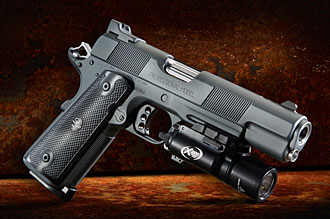 |
|
| Testing
firearms under extreme conditions is a normal part of
R&D at D&L Sports™ Inc.. It is obviously recommended
that you keep your firearms clean, properly lubricated,
and use proper magazines and ammo for the most reliable
performance. However, pristine operational conditions
are not always available in the real world. Extreme firearm
testing is conducted to see where reliability and durability
improvements can be made to assist firearms in maintaining
reliable function in harsh environments. Do not attempt
this type of testing yourself. A firearm mishap can cause
death or serious bodily injury. |
|
|
|
| Reliability
testing has been conducted in extreme heat, cold, wet,
muddy, sandy, and slushy conditions. Several important
lessons have been learned when it comes to 1911 field
reliability. |
|
|
|
|
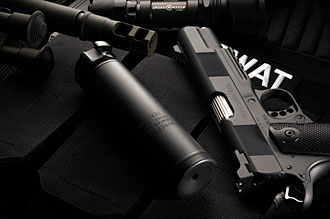 |
|
| A
properly fit pistol is more reliable than a loose assembly
of 1911 parts, no matter what myths you may have heard
about rattletrap G.I. 45s working better than professionally
constructed 1911s. Please keep in mind we are talking
about pistols properly fitted for service reliability.
Not too tight, not too loose, pistols constructed by a
1911 service pistol expert. |
|
 |
|
| Frail
target and competition pistols should not be considered
for service use. Overly tight guns constructed by those
interested in only shooting groups on paper, instead of
field reliability, fail quickly during extreme testing.
(This is not to say a properly fitted pistol is not snug
and consistent.) |
|
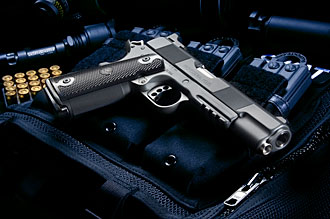 |
|
|
|
|
|
|
| Light
trigger pulls, minimum sear engagements, and light spring
rates all result in quick 1911 failure during extreme
reliability testing. |
|
| If
you are looking for a service pistol that will maintain
field reliability the longest, don't be mislead by competition
based pistol builders into thinking a pistol constructed
with light duty competition components is going to be
as long term reliable under field conditions as a professional
service pistol. |
|
| Insist
on a pistol designed for a steady diet of full power ammo
and one which is operated by all full power springs. Use
well designed magazines with full power mag springs. Do
not use magazines with minimized follower legs in order
to crunch in an extra round in the magazine. Get reliable
trigger components properly mated together for a long
service life, not finicky competition trigger parts which
need repeated "tune ups" |
|
|
| to function. Maintain
a full power hammer fall and primer strike. Don't be duped
into buying light mainsprings because "it will make
the trigger pull better". What it really does under
contaminated conditions is fail to fire the pistol. |
|
|
|
| Solid
service pistols are routinely subjected to severe testing
at D&L Sports™ Inc. in order to locate other areas
of the firearm which could benefit from design improvements. |
|
|
|
| Light
moisture and moderate dirt and snow were not much of a
reliability challenge. A full power service pistol generally
chugs right through it. A snug fit pistol does not allow
much dirt into the frame and slide rail areas. When common
soil type dirt does get in, it is generally ground up
and churned out of the edges of the slide with the pistol's
lubrication. It commonly has the appearance of sludge
coming out of the pistol. |
|
|
|
| When
mud shooting really gets extreme and mud is actually packed
in the pistol, any firearm can cease function. The first
areas to act up are commonly trigger and striker operations. |
|
|
|
| Another
area of concern is operation in sandy environments. Sand
is a difficult substance for your pistol to deal with
because sand can not be ground up and expelled along the
frame/slide rails as easy as soil type dirt. |
|
| Hard
particles of sand can cause substantial drag on your pistol
slide's operation. Since grains of sand are hard to crush
and expel, they have the capability of scoring and scaring
firearm materials. This is a good reason to hard coat
your pistol with a finish like hard chrome. It minimizes
pistol damage from sand lapping. |
|
| Dave
Lauck's solution to minimize sand interference with, and
damage to, your pistol has been to cut sand tracks and
recesses into the pistol's slide and frame. Since sand
is hard to grind up and expel, the tracks provide recessed
areas for the sand granules to migrate into and gather,
in other words, an interrupted slide/frame rail system.
Gathering the sand and grit in recesses keeps it away
from the sliding contact surfaces, thus minimizes it's
interference with pistol operation. |
|
|
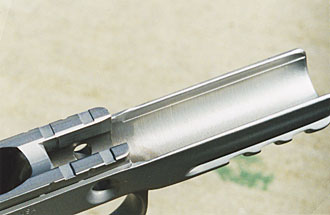 |
|
| This
custom upgrade has proven to be very effective for those
who operate in sandy environments. |
|
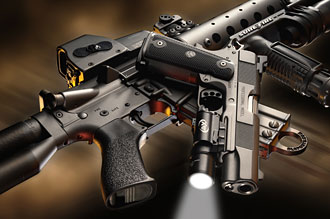 |
|
| It
is an option that should be selected at the beginning
of the 1911 construction process in order to allow the
sand cuts and tracks to be over finished along with the
rest of the pistol when it is complete. |
|
|
add
$175 |
|
|
|
| Another
area where there is little room for sand and grit is where
the slide moves over the barrel hood as the pistol functions.
This is typically a problem when a pistol is carried in
the field and the exposed barrel hood collects contaminants.
When the pistol is fired or otherwise cycled, contaminants
have opportunity to enter the inner workings of the pistol
and grind between the inside of the slide and the barrel
hood. Common dirt is generally ground into very fine particles
as the pistol continues to function. However, when the
pistol is contaminated with sand or other hard particles
which are difficult to grind up, grinding friction can
increase dramatically, sometimes enough to stop the slides
operation. |
|
|
|
|
In order to minimize this problem, recesses or flutes
can be machined on the outside of the barrel hood and
the inside of the slide. These recesses provide areas
where particles can migrate to, and remain, until formal
cleaning duties can be performed. Just like the sand cuts
in the pistol's rails, recesses on the barrel hood and
slide allow the pistol to run much smoother while dirty,
increase reliability, and minimize particle grinding wear
on your pistol. |
|
|
|
|
Barrel hood flutes $150 |
|
|
|
Extreme sand, mud, and dirt testing has also resulted
in binding trigger movement in the 1911. To minimize this
problem, trigger channels are now offered for 1911 triggers.
The channels work like the sand cuts in the slide and
frame, they allow recesses for contaminants to filter
into, thus minimizing drag on the trigger's operation.
|
|
|
|
|
$45 |
|
| Special
note |
| The
above described methods of minimizing operational drag
on 1911s has been developed and tested by Dave Lauck to
improve operation of your pistol in harsh conditions.
However, these options also work well on general every
day carry guns which collect their own share of dirt,
lint, and grit from being carried on a daily basis. |
|
|
|
|
|
| Cutting dirt and sand recesses in 1911 pistol barrels has proven to work so well that DL Sports Inc. now offers the same type of process for Glock 17 and 34 pistol barrels. Stainless steel 9mm Glock barrels with sand cuts are now in stock for the G17 and G34. Now your hard use pistol can be equipped with sand/dirt tracks around the outer chamber area of the barrel. This provides built in recesses to allow dirt, sand, and grit to be filtered out of the way and allow your slide to more smoothly pass over the top of your barrel hood when the pistol is fired while contaminated. |
Prices available on request |
|
|
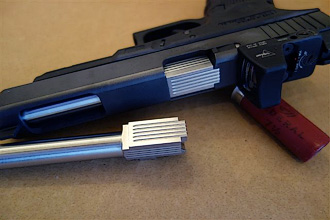 |
|
|
| |
|
|